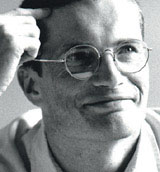Design needs you in its corner
Design’s benefit to business is hard to quantify, so it is hard to convince corporate types to put it centre stage.

I find it extraordinary that people are concerned about the future of the design world. Let me tell you there has never been a better time to be a designer. We live in a society driven by desires – they power the economy – and it’s design that understands and creates the desirable.
Design is now for everyone, not just an elite. Look at any industry and ahead of the competition, there is always a business that grasps the critical value of design. In homes Ikea, clothing Nike, technology Apple Computer, transport BMW, industry Airbus, culture Tate, addictions Starbucks, I could go on.
These companies have reinvented to lead their markets because their definition of design goes far deeper than treating it as merely some aesthetic ‘add- on’. For them, design is form and function in an organisational sense – combining business model with emotional model. It’s not just about product design, or the environments or the graphics – and it’s not just about marketing either. For these organisations design is part of their business process; it’s natural and it makes them better and different.
This more profound approach to design can also be seen beyond the commercial world. Live 8, Make Poverty History and the rise of the wrist band movement show us that mainstream society now wants its beliefs to be visible and demonstrative. It is no longer about discretion and modesty, but about big, bold and exciting initiatives.
Design understands the commercial benefit of our senses and what excites them. It understands our feelings of how the world could be better and what it is to be human.
So why is it that most organisations do not have design as a core belief? For the vast majority, design is treated as either a luxury to be indulged in sparingly or they leave it to accident and amateurs. Given that desire drives business, I’m always surprised at how resistant businesses often are to talk about emotion. It’s simply not the natural language of the boardroom. Executives share a common parlance with accountants – they find no problem in understanding each other when discussing the bottom line. But finding a way to articulate the desires of the senses that are essential for keeping that bottom line healthy makes them uneasy.
The challenges are on both sides. A designer that is content to remain insulated within the confines of craft, one that fails to engage with the talents around, will never produce work that is anything more than adequate. To raise the bar you need to be part of a bigger and more diverse team. On the other hand, companies that do have design departments should ask whether any of their creative inhabitants ever entered the boardroom without a feeling of fear and trepidation and, more importantly, whether they managed to influence the business decisions in the same way as the finance people did.
It is also tempting for businesses to template creativity; the template replaces judgement and imagination. This approach is appealing and even essential in some cases, but it is still a wretched substitute for any real engagement. Our creative industry must realise that it is not deep enough nor creative enough. At best it is just an example of superficial and empty corporate modernism.
Examples such as Terence Conran leaving Habitat and Vittorio Radice leaving Selfridges demonstrate that losing design from the very core of an organisation allows companies to slide back to business as usual and become like everyone else.
Businesses resist reinvention. But to stay noticed in a crowded marketplace, an organisation must always be open to the possibilities of ambitious, fundamental change. Are designers the only ones to be involved in this transformation? Obviously not, but change requires the designers’ ability to think in different ways, the ability to avoid the current successes, to take risks and break the rules. It also requires frustrating, argument-ridden, time consuming, surprising and enriching collaboration with a multitude of experts, from programmers to project planners, in order to get results. And sometimes it requires being a bit unreasonable.
When a business needs to transform itself, the beancounters may play a decisive role in measuring the process, but the process itself will be driven by those creatives who can discover delightful, insightful solutions.
Future success will be determined by optimism and a belief that the world can be a better place because there are better ways to do things. The winners will be those that embrace that vision. That’s what we all desire.
Lee Coomber is executive creative director of Wolff Olins
Leading businesses that grasp the value of design
The home: Ikea
Clothing: Nike
Technology: Apple
Transport: BMW
Industry: Airbus
Culture: Tate
Addictions: Starbucks
-
Post a comment




